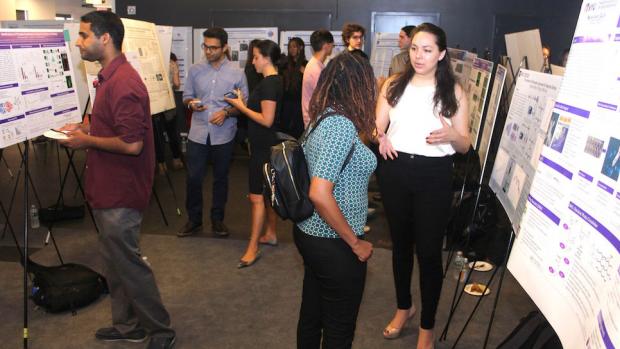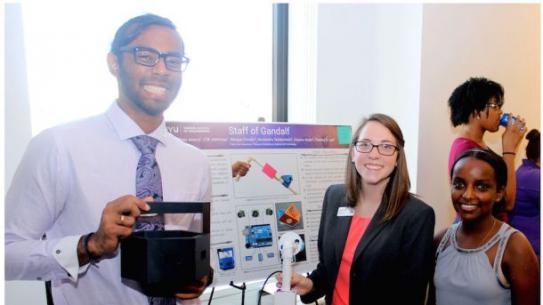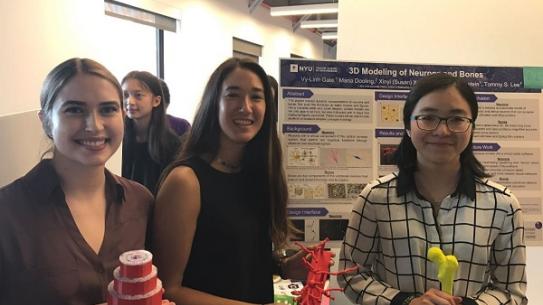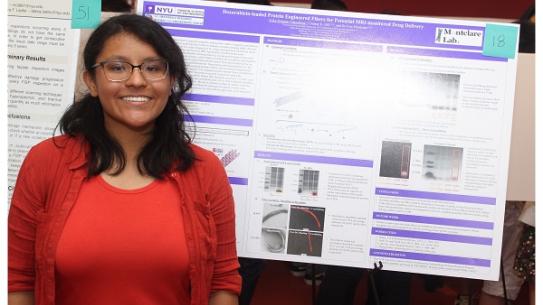Undergraduates Research Alongside Faculty through Summer Program

Fellow students, professors, and guests perused the over 70 projects undergraduate students worked on this summer at NYU Tandon laboratories. Photo source: Michael Campbell
This summer, students at NYU Tandon School of Engineering traded beach days and binge watching for data sets, 3D printed neurons and testing the durability of composite materials. Through the Undergraduate Summer Research Program at NYU Tandon, undergraduates have the unique opportunity to work alongside professors and doctoral researchers on the cutting-edge research happening in Brooklyn.
In addition to celebrating the program’s 11th year of introducing Tandon students to laboratory research, 2017 also marked the first year the program featured equal participation from male and female students. “We are excited that more women are getting involved in STEM and specifically STEM research. They bring a necessary diversity to the program that enhances it at every turn,” Sara-Lee Ramsawak, the program’s coordinator and Associate Director of Academic Affairs, said.
“Through the program, students learn about what research is and how it works, and work in teams with students of all different backgrounds and at different academic levels. The program can help them to plan for their future and determine if research is a path they want to take,” Ramsawak said, adding that the students discover faculty mentors, take part in academic and career development workshops, and work with a unique and multidisciplinary group of colleagues and researchers, as the program welcomes students from NYU Abu Dhabi and NYU Shanghai, as well as schools like Rutgers University and Michigan State.
On August 4, over 100 budding researchers gathered at MAGNET, the Media and Games Network, to present their research at a poster symposium. Read below to learn more about a few of the projects students worked on this summer:
Improving the White Cane and Models of Neurons, Bones, and Skeletal Muscle

A cohort working with chemical and biomolecular engineering lecturers Alexandra Seidenstein and Tommy S. Lee merged applied biology with technology in projects ranging from a modified white cane for the visually impaired, a Dash Cam that enables a smartphone’s front and rear camera to simultaneously record in vehicles, and 3D printed neurons, bones, and skeletal muscle that aid education through 3D orientation. Seidenstein shared that both she and Lee foster an interdisciplinary environment in their lab, ranging from students in biochemistry to computer science. “We also don’t have graduate students, so our undergraduates are running their own projects, which is a unique experience,” Seidenstein said.
“Typical white canes do not detect objects, and other options like guide dogs are very expensive to maintain,” explained Aida Aberra, an NYU Abu Dhabi student who worked on the Staff of Gandalf — an electronic transport aid that reimagines the white cane. Aberra and her fellow teammates Abhiroop CVK, a biomedical major from NYU Tandon and NYU College of Arts and Sciences, and Morgan Fender, a rising senior at Missouri University of Science and Technology, used sensors to detect obstacles and solenoid pins that alert the user through pulses. The Staff of Gandalf also took home the symposium’s top poster prize.

Two other projects turned towards 3D printing to visualize the structure of neurons, bones, and skeletal muscle at the molecular level. Xinyi Xu of NYU Shanghai, Vy-Linh Gale of NYU Tandon, and Maria Dooling of Arizona State University developed 3D demonstrations of the intricately detailed cells and synapses, as well as enhanced bone models of bone’s microstructure and cross-sections. “3D modeling can create clearer scientific visualizations for students, so complex scientific concepts can be printed and held in a student’s hand, offering them a tangible, better understanding,” Xu said. NYU Tandon student Mackensie Gross and Ian Wright from University of Rochester used 3D printers to model filaments in skeletal muscle, drastically improving current two-dimensional models.
Engineering Proteins for Drug Delivery and MRI-Monitoring

Chemical and biomolecular engineering student Erika Delgado-Fukushima joined professor Jin Kim Montclare’s laboratory this summer researching the ability of the coiled coil microfiber variant of the cartilage oligomeric matrix protein to self-assemble and bind to chemotherapeutic drugs like doxorubicin. With these engineered proteins capable of drug delivery, Delgado-Fukushima explained that continuing research is exploring whether binding certain molecules to the protein’s fibers, like iron oxide nano-particles, could make the delivery of the protein and attached doxorubicin more visible and easier to monitor through MRI. Montclare and fellow scientists recently published an article on a protein capsule that binds with doxorubicin and gene silencers to combat cancer, adding an exciting factor to Delgado-Fukushima’s research.
Pairing Information Theory with Fish Schooling
Within mechanical and aerospace engineering professor Maurizio Porfiri’s Dynamical Systems Laboratory, NYU Tandon students Antonios Gementzopoulus and Maxwell Rosen explored the validity of information theory to researching hydrodynamic interactions within swimming fish. Past theories on schooling fish have rested upon fluid dynamics and to better understanding schooling fish. As past theories have rested upon fluid dynamics, information theory and transfer entropy offer a model-free approach and could be a useful tool for researching the information flow between fish in schools. By simulating and tracking pitching airfoils traveling upstream and downstream, the team discovered that there is greater information flow when fish are closer together — an interaction that decreases with longer distances between fish.
Camila Ryder
Graduate School of Arts and Science
Master of Arts in English Literature, Class of 2018




